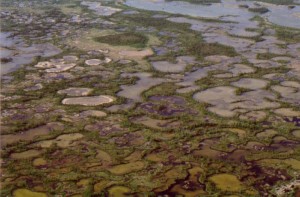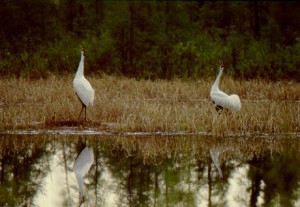by Chester McConnell, Whooping Crane Conservation Association
After their long 2,500 mile migration, most whooping cranes have reached their Wood Buffalo National Park (WBNP) nesting grounds. Most of those that arrived early are already nesting and others will be soon. Hopefully they will have a successful hatch this year and raise the population above the 300 level.
A few of the mostly sub-adult whoopers are still arriving at Wood Buffalo. They can take their time because they are not involved in building nests, incubating eggs and raising the next generation.
Once the adult cranes settle in and re-establish their territories they begin nest construction, which usually takes a couple of days. Generally 2 eggs are laid about 2 days apart. Incubation begins with the laying of the first egg and it usually takes about 30 days before hatching.
Whooping Crane breeding territories are in the extreme north-eastern corner of WBNP. The park itself covers 11 million acres (44,000 sqkm) while the breeding area is contained within a 1.5 million acres (80 x 80 km area). The nesting area lies among the large marshes adjacent to the Sass, Klewi, Nyarling and Little Buffalo rivers. Each nesting territory is a mosaic of small to large shallow wetlands with bulrush, sedge and cattail as the dominant emergent vegetation. In among the wetlands are low ridges and upland areas dominated by black spruce, willow and dwarf birch. The photo shows typical whooping Crane wetland nesting area in Wood Buffalo National Park, Canada. Note the numerous shallow wetland ponds.
numerous shallow wetland ponds.
How many whoopers will be nesting this year? No one knows. We will have wait for the “official” information until late October 2013 when the Canadian Wildlife Service advised they will issue their next report. Currently we are depending on information that we get from interested private citizens. To get some idea about nesting efforts we must check data from last year (2012). In May 2012 sixty seven (67) whooping crane nests were discovered by the Canadian Wildlife Service. Three months later in August, an additional three (3) familygroups were identified indicating that there were at least sixty-nine (69) nesting attempts during the 2012 nesting season. In early August, just prior to fledging, thirty-four (34) young were observed on the breeding grounds. Two (2) sets of twins were observed. Ten of the young whooping cranes were marked with leg bands and satellite transmitters. Of the 67 nests detected in 2012, five were in new territories (all within WBNP) and five were outside of the national park (two in the Lobstick Creek area, and three north of the Nyarling river). Based on the 2012 data and average whooping crane population increases the Whooping Crane Conservation Association projects 75 nests in 2013.
During 2012, habitat conditions on Aransas National Wildlife Refuge were below average but the resourceful whoopers appeared to be in good condition as they began the migration to Canada. When the whooping cranes arrive on the nesting grounds in good condition, nesting success is usually good. Hatching usually takes place during the first 2 weeks of June.
Both photos in this article were taken by Brian Johns, President, Whooping Crane Conservation Association.

